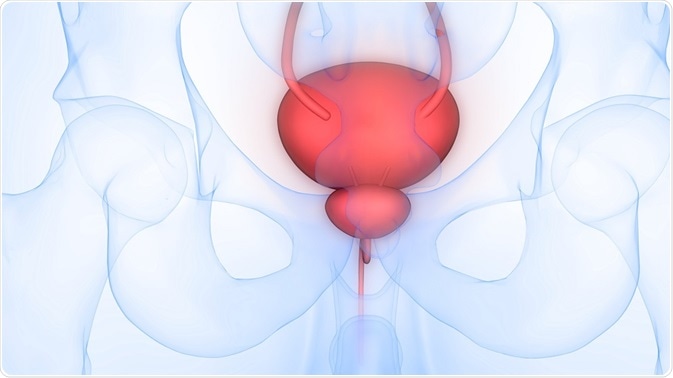Endoscopy (or endoscopic imaging) is the internal visualisation of an organ using a camera encapsulated within a long, flexible tube. Endoscopy of the bladder, more commonly referred to as cystoscopy, is the gold standard for detection and monitoring bladder cancer.
 Image Credit: magic mine / Shutterstock
Image Credit: magic mine / Shutterstock
There are many different types of endoscopy, dependent upon the specific organ being examined, however they all allow the visualisation of internal hollow structures. The most common form of cystoscopy used to bladder cancer detection is white light cystoscopy (WLC).
What is white light cystoscopy (WLC)?
In WLC, a camera and light are contained within a long tube, which enters the body through the urethra and eventually reaches the bladder. This relays an image back to urologists, who then examine the internal structure and search for abnormalities. These images can be used to investigate a wide range of issues, such as hematuria, bladder stones, incontinence, urinary tract infections and bladder cancers.
There are two available types of WLC. Flexible cystoscopy involves a flexible tube, and can usually be carried out with only local anaesthesia which is placed upon the entrance to the urethra a few minutes before the procedure is carried out. However, rigid cystoscopy requires general anaesthetic as insertion is more painful, particularly for males, due to the inflexibility of the tubing.
There are a few risks associated with this method of diagnosis, including urinary tract infections or blockage of the urethra. However, this procedure is usually very safe and serious complications are extremely rare.
WLC and bladder cancer
The WLC method is commonly used to examine the cells within the bladder wall for detection of malignancies. If abnormal cells or tumors are detected, an instrument is passed through the cystoscope tube and a sample is taken for a biopsy, which can be used to further confirm the diagnosis.
Enhancements in endoscopic imaging
The gold standard for bladder cancer detection via imaging is through white light cystoscopy, as previously described. However, this method has several draw backs such as failure to detect small papillary tumors and transitional carcinoma in situ. Therefore, there are several methods which are currently being developed to circumvent these problems.
One such example is fluorescence cystoscopy (or blue light cystoscopy). This method involves the insertion of a photosensitizing agent into the bladder, which is then analysed using a camera and a fluorescent light. This dye is taken up at higher levels in cells which are hypermetabolic, meaning that cancerous cells take it up at higher levels than surrounding tissue.
Upon activation with the fluorescent light, these cells become a bright shade of red, allowing more accurate detection of both papillary tumors and transitional carcinoma in situ.
This method has been tested by a large range of studies, showing that it is both more accurate and sensitive than the previous WLC methodology. Overall, it may lead to increased early diagnosis, increased prognosis and decreased recurrence rates.
One issue with this method is the frequent occurrence of false-positive results. This can occur due to auto-fluorescence, in which endogenous fluorophores within our cells are activated by the fluorescent light, or through inflammation.
Overall, endoscopic imaging is a very important, yet highly invasive, method for detection and monitoring bladder carcinomas. Through the examination of internal organs, abnormal cells and tumors can be identified, leading to a biopsy and an early diagnosis.
Further development of cystoscopy methods includes blue light cystoscopy, which uses fluorescence to detect poorly visualised cancer types. In combination, these methods lead to early and accurate diagnosis, allowing intervention and leading to increased patient prognosis and lower recurrence rates.
Sources:
- https://www.nhs.uk/conditions/cystoscopy/
- www.cancerresearchuk.org/…/cystoscopy
- https://link.springer.com/article/10.1007%2Fs11934-014-0406-5
- https://www.europeanurology.com/article/S0302-2838(09)00791-X/fulltext
- www.europeanurology.com/…/innovations-in-endoscopic-imaging-for-bladder-cancer
- https://onlinelibrary.wiley.com/doi/full/10.1002/cncr.25521
Further Reading
- All Bladder Cancer Content
- What is Bladder Cancer?
- What Causes Bladder Cancer?
- Bladder Cancer Diagnosis
- Bladder Cancer Treatment
Last Updated: Feb 26, 2019

Written by
Hannah Simmons
Hannah is a medical and life sciences writer with a Master of Science (M.Sc.) degree from Lancaster University, UK. Before becoming a writer, Hannah's research focussed on the discovery of biomarkers for Alzheimer's and Parkinson's disease. She also worked to further elucidate the biological pathways involved in these diseases. Outside of her work, Hannah enjoys swimming, taking her dog for a walk and travelling the world.
Source: Read Full Article
